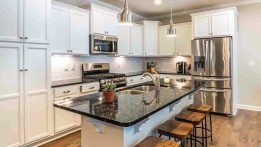 Interior doors are an important part of your home’s overall look and significantly impact its inner “curb appeal.” While it’s often easy to overlook these doors as just part of a home’s background appearance and focus, replacing interior doors not only helps tie a space together visually, but offers other benefits.
Interior doors are an important part of your home’s overall look and significantly impact its inner “curb appeal.” While it’s often easy to overlook these doors as just part of a home’s background appearance and focus, replacing interior doors not only helps tie a space together visually, but offers other benefits.
1. Reasons to replace interior doors
First, consider replacing or upgrading your interior doors if they are of differing types and colors. If doors in the same area of a home — kitchen, living room, upstairs bedroom, basement — don’t match, the entire space loses cohesion. Older homes that have been through several renovations may have a hodge-podge of door types on their main and upper levels; replacing all the doors on the same level with those of a consistent look or theme can improve the house’s visual flow.
It’s also worth replacing interior doors if they’ve become damaged or no longer sit properly in their frames. Hollow core-doors are especially vulnerable to damage from bumps and kicks. Minor damage to solid wood doors can be more easily corrected by sanding and then staining or painting again, but these heavier doors are also more prone to moving out of alignment with their frame. A wood door that won’t close properly and has significant damage may be better used elsewhere in a home or repurposed by a craftsman.
2. Types of interior doors
 There are a large number of interior door types to choose from, including:
There are a large number of interior door types to choose from, including:
- solid wood doors
- faux wood doors
- engineered wood doors
- bi-fold doors
- fire-resistant doors
- pocket doors
- accordion doors
- French doors
Each type of interior door offers its own benefits. Solid wood doors, for example, are an excellent choice if you want to stop sound transmission from room to room. Fire-resistant doors can offer up to a half-hour of protection in the event of a house fire and are a great choice for bedrooms. Pocket doors slide into walls rather than swinging open and are a good choice for a smaller space.
3. Changing interior door trim
 One simple way to update the look of an interior door without replacing the entire door is to change the door trim. Removing and replacing door trim can typically be done in the course of an afternoon. You’ll need a pry bar and some patience to remove the old trim and new trim to replace what you’re removing. There are many trim types available from flat, easy-paint options to larger, flared crown molding. You can also find decorative corner blocks or lintels to match your tastes — just make sure they match the rest of your trim.
One simple way to update the look of an interior door without replacing the entire door is to change the door trim. Removing and replacing door trim can typically be done in the course of an afternoon. You’ll need a pry bar and some patience to remove the old trim and new trim to replace what you’re removing. There are many trim types available from flat, easy-paint options to larger, flared crown molding. You can also find decorative corner blocks or lintels to match your tastes — just make sure they match the rest of your trim.
4. Replacing interior doors
If you choose to replace some or all of your existing interior doors, you’ll discover they come in two varieties: pre-hung and “blank,” or slab. Pre-hung doors have their jambs pre-attached, and space in the wall was made to accommodate door and jamb together. Blank, or slab, doors are crafted to fit into a jamb already set in the wall.
 Replacing a blank door means you either need to like the jamb that’s in place or be willing to do the work of removing it all. Once you’ve purchased a new blank door, the next step is to remove the old door, lay it on top of your new door, take measurements and cut them to match. The height of any door you want to replace will likely be a standard 80 inches but make sure to double check its width. There are a variety of standard sizes. Also, be aware that many manufacturers use shorthand when they talk about a door’s width; 3-0, for example, means three feet, zero inches, not 30 inches.
Replacing a blank door means you either need to like the jamb that’s in place or be willing to do the work of removing it all. Once you’ve purchased a new blank door, the next step is to remove the old door, lay it on top of your new door, take measurements and cut them to match. The height of any door you want to replace will likely be a standard 80 inches but make sure to double check its width. There are a variety of standard sizes. Also, be aware that many manufacturers use shorthand when they talk about a door’s width; 3-0, for example, means three feet, zero inches, not 30 inches.
Replacing a pre-hung door means removing the door and jamb, but you won’t have to worry about cutting a new door to the proper size. It does have to fit perfectly in the wall opening, however, which means using wooden shims and a great deal of patience to get it just right.
5. Hiring a contractor to install interior doors
 While it’s possible to install new pre-hung and blank interior doors in your home yourself, you’re often better served by hiring a professional contractor to do the work. Not only can they do the work more quickly and with a far lower chance of mistakes (making sure the door swings the right way, for example), they can often recommend what type of door will work best in your home.
While it’s possible to install new pre-hung and blank interior doors in your home yourself, you’re often better served by hiring a professional contractor to do the work. Not only can they do the work more quickly and with a far lower chance of mistakes (making sure the door swings the right way, for example), they can often recommend what type of door will work best in your home. ![]()
By Doug Bonderud




